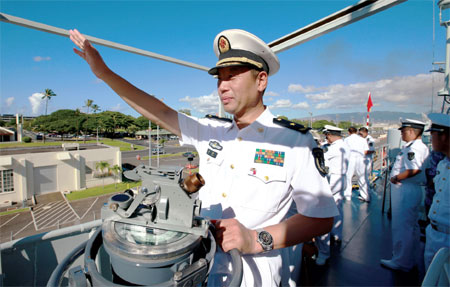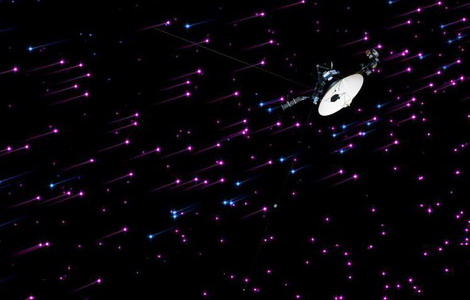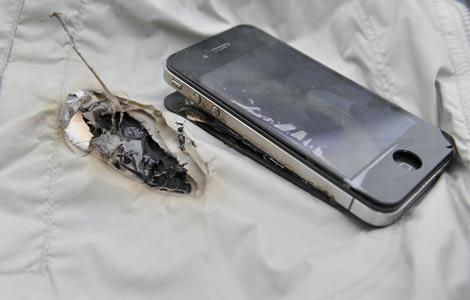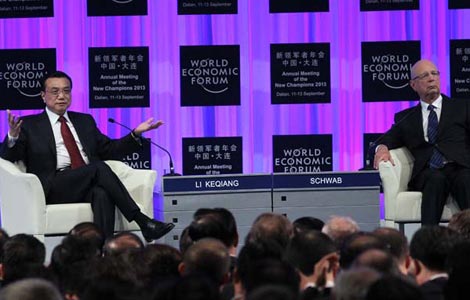Chinese navy chief cruises into DC
Updated: 2013-09-13 11:44
By Chen Weihua in Washington (China Daily)
|
||||||||
|
Admiral Wei Gang, chief of staff of China's North Sea Fleet and commander of a Chinese navy fleet visiting Hawaii, waves goodbye to his US counterparts in Pearl Harbor on Monday, after three Chinese navy ships and 680 crew members conducted a search-and-rescue drill with the US navy on the day. Zha Chunming / China Daily |
With a 19 gun salute and naval honor guard, Chinese People's Liberation Army Navy's commander-in-chief Wu Shengli was welcomed on Thursday morning to the Washington Navy Yard by his US counterpart Jonathan Greenert.
The national anthems of both China and the United States were played in the oldest onshore establishment of the US Navy, now a ceremonial and administrative center for the Navy and home base for Chief of Naval Operations Greenert.
Wu, who started his US trip on Sunday, said the US attaches great important to his visit and has made elaborate arrangements and provided a warm reception, all of which have made his trip a great success.
Greenert, who assumed his current post in 2011, expressed a hope for expanded cooperation between the two navies. "The purpose of this visit here this week has been to continue military-to-military relations, and, involving our mature relationship, look for great opportunities to share common interests and move ahead in our cooperation," said Greenert, who has been invited to visit China next year.
Wu brought along with him to Washington commanding officer Zhang Zheng of China's first aircraft carrier Liaoning and Dai Mingmeng, the first pilot to complete a tail-hook landing on the carrier. Wu talked to his US counterpart about the future development of China's aircraft carriers.
He told the media on Thursday that the Chinese navy has displayed a high-degree of transparency to the US adding that there were two reasons why he brought the two aircraft carrier officers along on the trip.
"One is for them to have a close look at the US Navy. And the other is for friends from the US Navy to get to know them up close. Isn't that transparency?" said Wu.
It was Wu's second trip to the US since 2007. Earlier this week, he visited the San Diego-based Pacific Fleet units, including Nimitz class supercarrier USS Carl Vinson, and Los Angeles-class submarine USS Jefferson City in port as well as Freedom class littoral combat ship USS Fort Worth at sea and the US Marine Corps Base Camp Pendleton.
While Wu travels in the US, a PLA Navy fleet joined the US Navy on Monday in search-and-rescue exercises off Hawaii. The two navies sent out four ships, three helicopters and more than 1,000 officials and sailors.
The three participating Chinese ships, Qingdao, a luhu-class destroyer, Linyi, a Jiangkai-class frigate, and Hongzehu, a Fuqing-class fleet oiler, were carrying a helicopter and 680 officers and sailors. The US side dispatched guided missile cruiser USS Lake Erie, an SH-60 Seahawk helicopter and a UH60 Blackhawk helicopter.
It was the first such port visit by the Chinese navy since 2006, when Qingdao and Hongzehu stopped at Pearl Harbor and San Diego for communications drills and search-and-rescue exercises.
The joint drill in Hawaii also came less than two weeks after Chinese destroyer Harbin and auxiliary replenishment oiler Weishanhu joined the guided-missile destroyer USS Mason for joint two-day anti-piracy exercises in the Gulf of Aden. The two navies also held a joint anti-piracy exercise off Somalia in 2012.
The Marine Corps Times reported that Greenert stressed the importance of having the Asia-Pacific region's two most powerful fleets working together in such relief efforts, and in combating smuggling and piracy. "We need a systematic set of protocols with respect to the freedom of navigation that exists out there," Greenert said. "What we want to do is get a consistent code of conduct, such as how do we talk to each other when we come across each other out there."
More attention-grabbing bilateral military cooperation will take place next year when the Chinese navy participates in the biennial 2014 Rim of the Pacific exercise, the world's largest naval drill, for the first time. During his trip to China last September, then US Defense Secretary Leon Panetta extended the invitation to the Chinese for the drill, to be participated in by more than 20 nations.
"We want [China's] participation in RIMPAC to be as successful as possible, and a building block to future cooperation," Greenert was quoted as saying on the US Department of Navy website.
Also on Monday, a US delegation led by Undersecretary of Defense for Policy James Miller was in Beijing with a Chinese delegation led by Wang Guanzhong, deputy chief of the PLA General Staff for the 14th annual Defense Consultative Talks.
Both Miller and Wang stressed the accomplishments that the US-China military-to-military relationship has achieved thus far this year. They discussed how to sustain positive momentum in building a constructive military relationship and advance a new model of military-to-military relations for the future, according to a Pentagon press release.
Bilateral military exchanges have been on the rise in the past two years. But US Congressional laws still restrict the types of cooperation that are deemed as helping increase the PLA's combat capability. Senior Chinese military officials have described the laws as a hindrance to bilateral ties.
chenweihua@chinadailyusa.com
(China Daily USA 09/13/2013 page1)
Most Viewed
Editor's Picks

|

|

|

|

|

|
Today's Top News
China's ICBC set to expand in Canada
Florida college joins push for ties with China
China supports trade ties: Michigan governor
Markets hold breath over Chinese cotton policy
Economist calls for global Marshall Plan
'Green Fence' puts pressure on US recyclables
One in four men in Asia-Pacific admit to rape
WB head to discuss climate in China visit
US Weekly

|

|














